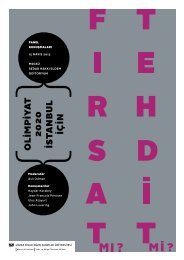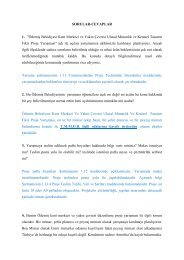VitrA ÃaÄdaÅ Mimarlık Dizisi - Arkitera
VitrA ÃaÄdaÅ Mimarlık Dizisi - Arkitera
VitrA ÃaÄdaÅ Mimarlık Dizisi - Arkitera
Create successful ePaper yourself
Turn your PDF publications into a flip-book with our unique Google optimized e-Paper software.
hotels and holiday resorts opened in metropolitan cities and coastal regions introduced<br />
new sub-categories to the sector, such as congress, golf or winter tourism. Consequently<br />
the natural, economical and social structure of especially the coastal regions has<br />
radically changed during the last three decades. Territories previously used as fields,<br />
pastures or forests have been rapidly transformed to tourism zones. Tourism has also<br />
become an important source of employment with the thousands of people including<br />
guides, waiters, gardeners and animators working for tourists. Small and large scale<br />
investors including pension operators as well as companies owning international hotel<br />
chains are active in the sector. Parallel to these developments, having a pleasant vacation<br />
in different places, relaxing and having a good time have become a significant<br />
part of peoples’ dreams and desires. In other words, tourism has culturally and socially<br />
become a necessity.<br />
How can we interpret the increasing variety and expansion in tourism activities? How<br />
do these developments influence and transform the ways people see and perceive<br />
the world? In order to respond to these questions, it is necessary to focus primarily on<br />
the recent general transformation in the practices of consumption. According to many<br />
social scientists, immaterial forms of production such as the image or the symbol have<br />
become more dominant in economic and social life of after the 1970s. This can be<br />
considered an important sign of the expansion of the particular consumption characteristics<br />
of tourism to include other social processes. This expansion has reversed the<br />
differentiation between the fields of art, sports, education, shopping and popular culture,<br />
trivializing the differences under the umbrella term of consumption. The rising influence<br />
of consumption activities in all areas of life has brought along the aesthetization<br />
of daily life. In this process of aesthetization, people have become more selective and<br />
meticulous, with consumption activities becoming the centerpiece for the formation and<br />
expression of cultural identity. In other words, modern man has transformed into a<br />
being that continuously defines its identity based on what it consumes rather than<br />
what it produces. This state of mind also involves the concern of creating the new<br />
image while consuming. One of the most important consequences of this development<br />
is that consumption has become less functional. Consumption activities are directed<br />
by image-based and symbolic concerns rather than physical and biological benefits<br />
or usefulness. In today’s world in which symbolism has become increasingly<br />
important, different fields of consumption have started to move closer to each other,<br />
and even merge together. As the language, production techniques, marketing methods<br />
and forms of consumption in diverse fields such as television and art, food and sports<br />
begin to resemble each other, the clear borders that used to exist between various<br />
fields have begun to dissolve. Put simply, the expansion and diversity in tourism has<br />
primarily occurred as a result of radical transformations in the field of consumption.<br />
Holiday resorts in general can be considered an example of this phenomenon. With<br />
the increase in their number during the 1980s, holiday resorts have frequently been<br />
portrayed in news and advertisements as symbols of a modern and luxurious<br />
vacation. Initially intended to attract foreign tourists, holiday resorts have become, over<br />
time, part of the dreams of local tourists, especially the wealthy and young middle<br />
class. Today, the architecture, interior and environmental design, accessories and even<br />
the costumes of staff are determined by a specific theme in most holiday resorts.<br />
In other words, the vacation experience not only offers the sea, the sun, the beach<br />
20

















